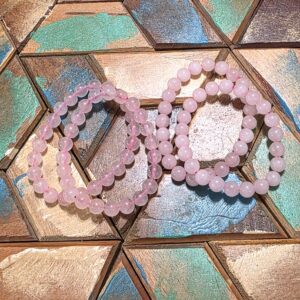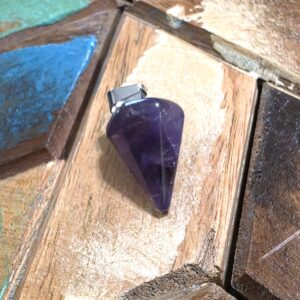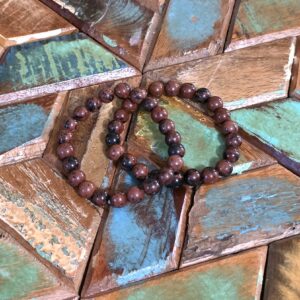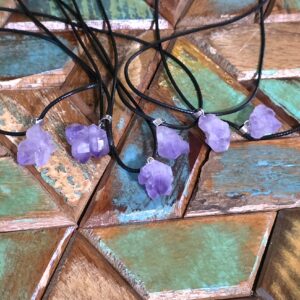Description
Cat’s Eye Glass Bracelets – Affordable Color Therapy, Intuitively Chosen
Discover the vibrant world of cat’s eye glass bracelets—available in 15 stunning colors, each meant to bring a pop of wearable color to your everyday life. These bracelets are crafted from high-quality synthetic cat’s eye glass beads, known for their captivating chatoyancy: a luminous band of reflected light that dances across each bead, mimicking the natural “cat’s eye” effect seen in certain minerals. Cat’s eye glass bracelets make a thoughtful gift or a personal treat, offering a blend of beauty, affordability, and color variety for any collection.
Bead size: Most of our bracelets are 6–9mm.
Choose Your Color, Embrace Your Intention
With 15 varieties to choose from, you can select the color that resonates most with your mood, style, or intention. Once your color is chosen, each piece is hand-picked—either intuitively or randomly, depending on your beliefs—making every bracelet a unique experience. This process adds a personal touch and a sense of surprise or synchronicity to your selection. Don’t worry, though—we hand pick each piece so that only the most lovely pieces make it to our store!
“Permission Slips” & Color Therapy
These bracelets were thoughtfully added to our collection to offer a financially-accessible, wearable option for those interested in color therapy. In the spirit of Bashar’s teachings, a “permission slip” is any tool, ritual, or object that helps you give yourself permission to experience a desired change or state of being. For some, simply wearing a certain color can serve as a gentle reminder or catalyst for positive feelings or intentions. Whether you see your bracelet as a meaningful symbol or just a fun accessory, the choice is yours.
As a color therapy practitioner, it is one of my preferred permission slips because of the psychology of color and how much fun it is to play in the interesting world of color and vibrations.
Quality & Care
Each
cat’s eye glass bracelet is crafted for comfort and durability, with smooth, polished beads and a flexible elastic band to fit most wrists. The glass beads are dyed during production to achieve their vibrant hues. To keep your bracelet looking its best, avoid exposure to harsh chemicals or prolonged sunlight, as colors may fade over time.
About Cat’s Eye Glass
Cat’s eye glass and their beads are popular for their distinctive optical effect, called chatoyancy—a luminous band that moves across the bead’s surface, resembling the slit eye of a cat. “Cat’s eye” is not a gemstone species, but a term for this effect, which can naturally occur in various minerals such as chrysoberyl, quartz, and tourmaline. Tiger’s eye is a well-known variety of quartz with a fibrous structure that creates a related, but more layered, appearance. Cat’s eye glass is a manmade material designed to mimic this optical phenomenon.
The manufacturing process involves melting glass and introducing fibers or metallic oxides that align during cooling, producing the signature reflective band.* The glass can be shaped into various bead forms, including rounds, ovals, and faceted styles. To achieve a wide range of colors, cat’s eye glass beads are often dyed or colored during the glassmaking process by adding different metal salts or pigments. Some beads may also be surface-dyed after formation for more vibrant or unusual hues.
Cat’s eye glass beads are valued for their affordability, durability, and striking appearance. If you’re comparing to other manmade beads, cat’s eye glass is similarly priced or just slightly higher due to the extra step of creating the chatoyant effect, but it’s still very accessible for most producers and buyers. This makes them a versatile and attractive choice for fashion jewelry and decorative crafts. However, it’s important to note that the dyes may fade over time if exposed to sunlight or chemicals.
*Some say this is spun fiber optic glass. I’m not sure of the difference, but even with extensive searching, I couldn’t find specific information about the manufacturing or creation processes except what is given here and repeated nearly everywhere.
While these are not dyed satin spar gypsum (often mislabeled as selenite), we do have those
here.
Please Note:
- Sizes and weights are approximate. Dimension sizes can vary based on the way the rock is formed. We hand measure our pieces on the longest side. Please see the pictures in the listing.
- The colors may vary due to monitor and lighting differences. We take our own product photos at this time. We are experimenting with lighting as we go.




Reviews
There are no reviews yet.